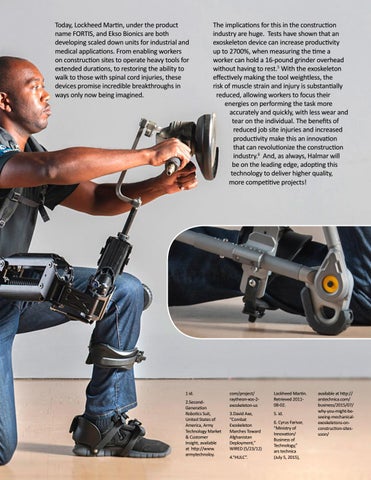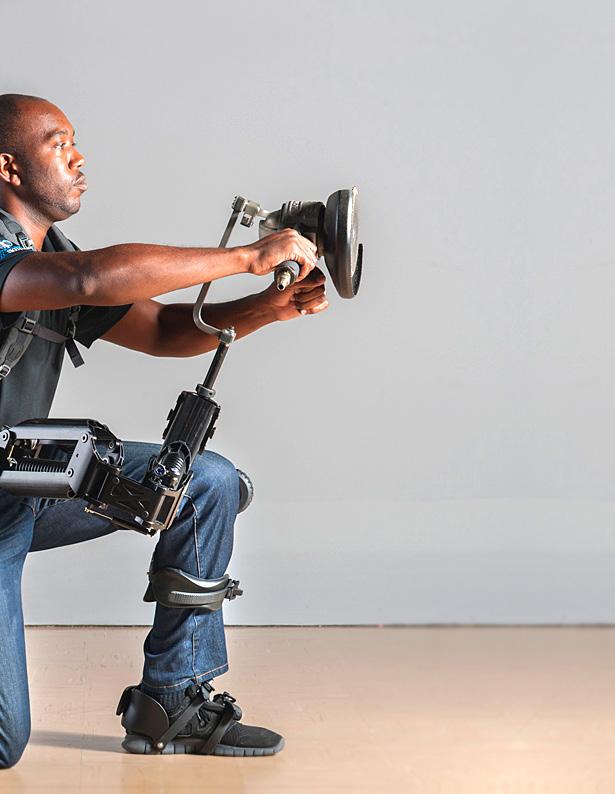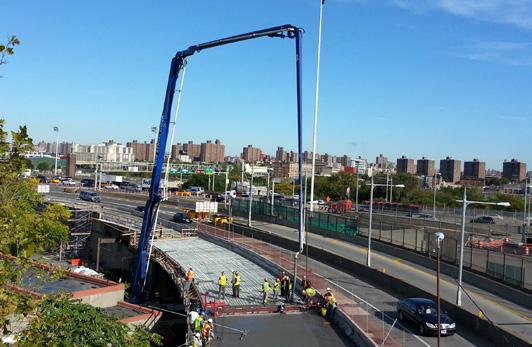EXOSKELETONS: TRANSFORMING THE JOB SITE According to Arcadis, a major construction consultancy, global construction output will grow 70% by 2025. 1 To meet the growing demand for additional capacity. Our industry must look to innovative solutions and technologies. ENTER THE “EXOSKELETON,” a wearable robotic suit that augments the strength of its wearer. As this nascent technological innovation leaps from the pages of science fiction into reality, new applications are rapidly emerging in the military, medicine, manufacturing and we believe, in the not distant future, construction. Beginning in 2001, the US Defense Advanced Research Projects Agency (DARPA) allocated $50 million dollars for a five-year program: the Exoskeletons for Human Performance Augmentation project.2 Only two of the numerous participating firms have been in active development: Raytheon and Lockheed Martin. Both firm’s devices use hydraulic actuators to control the external spine, hips, legs, and arms the suit provides the wearer, providing hyper-human strength, for carrying heavy military equipment on long marches, or to run at speeds beyond normal human performance capabilities.3 The Raytheon system, called XOS 2, has a 17:1 perceived to actual weight ratio, which the Army estimates will triple the work capacity of its
Today, Lockheed Martin, under the product name FORTIS, and Ekso Bionics are both developing scaled down units for industrial and medical applications. From enabling workers on construction sites to operate heavy tools for extended durations, to restoring the ability to walk to those with spinal cord injuries, these devices promise incredible breakthroughs in ways only now being imagined.
soldiers, reducing manpower requirements and cost. The Lockheed Martin system, known as the Human Universal Load Carrier (HULC), originally developed by Professor H. Kazerooni and his team at Ekso Bionics, utilizes hydraulics powered by a lithium-ion battery pack, freeing the wearer from being tethering to a power source, and enables soldiers to carry loads of up to 200 pounds at up to 10 mph. In 2009, Ekso Bionics reached an exclusive licensing agreement with Lockheed Martin’s Missiles and Fire Control business unit.4 Their continued development of the technology resulted in smaller, lighter weight units, with lower power demands that can conduct up to 8-hour missions.
The implications for this in the construction industry are huge. Tests have shown that an exoskeleton device can increase productivity up to 2700%, when measuring the time a worker can hold a 16-pound grinder overhead without having to rest.5 With the exoskeleton effectively making the tool weightless, the risk of muscle strain and injury is substantially reduced, allowing workers to focus their energies on performing the task more accurately and quickly, with less wear and tear on the individual. The benefits of reduced job site injuries and increased productivity make this an innovation that can revolutionize the construction industry.6 And, as always, Halmar will be on the leading edge, adopting this technology to deliver higher quality, more competitive projects!
1 id.
HIWAY | 34
2.SecondGeneration Robotics Suit, United States of America, Army Technology Market & Customer Insight, available at http://www. armytechnoloy.
com/project/ raytheon-xos-2exoskeleton-us
Lockheed Martin. Retrieved 201108-02.
3.David Axe, “Combat Exoskeleton Marches Toward Afghanistan Deployment,” WIRED (5/23/12)
5. id.
4.“HULC”.
6. Cyrus Farivar, “Ministry of Innovation/ Business of Technology,” ars technica (July 5, 2015),
available at http:// arstechnica.com/ business/2015/07/ why-you-might-beseeing-mechanicalexoskeletons-onconstruction-sitessoon/
HIWAY | 35







